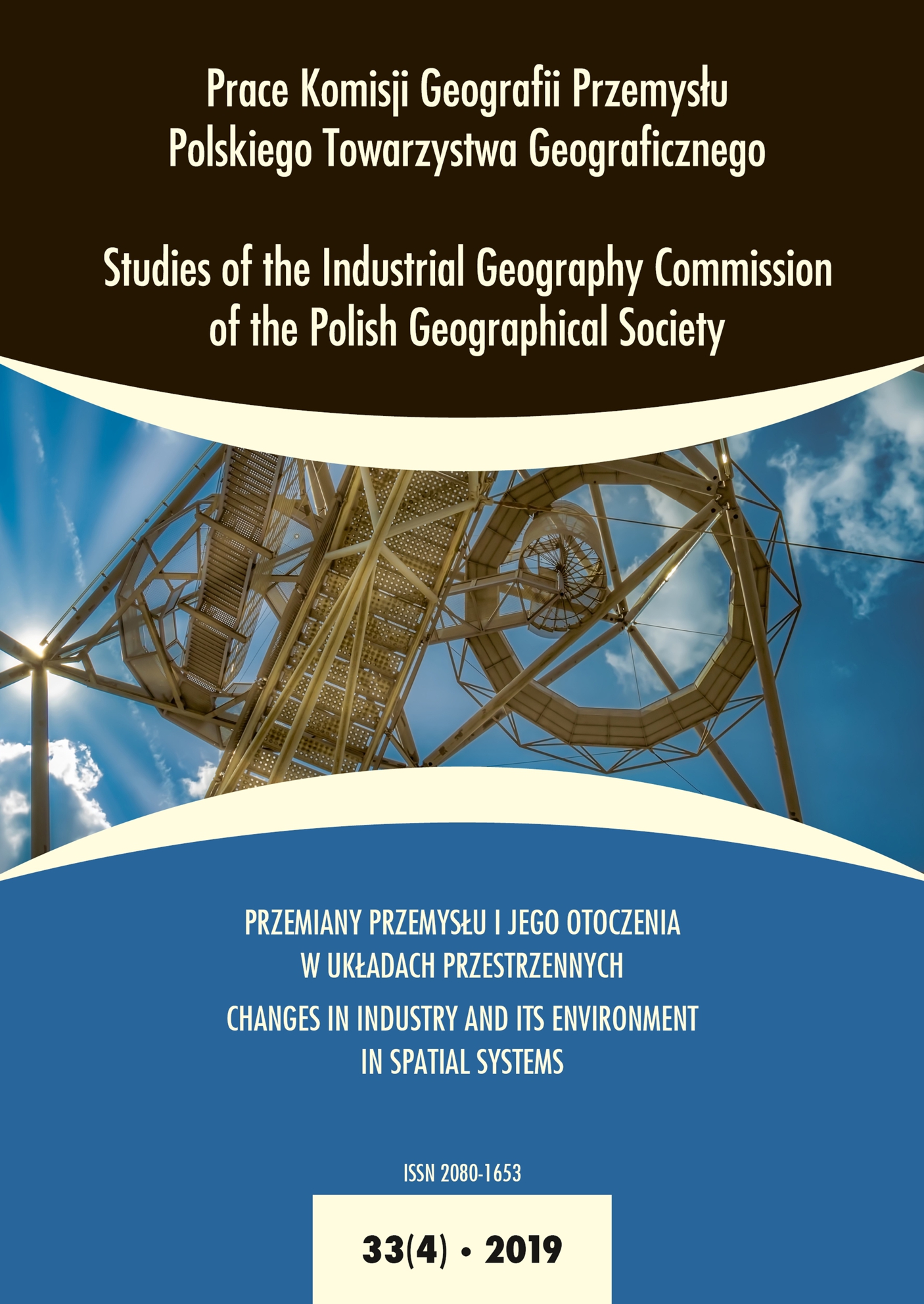Processes of Concentration and Specialisation of Industry in Dolnośląskie Voivodeship in 2005–2016 – Spatial Perspective
DOI:
https://doi.org/10.24917/20801653.334.3Keywords:
Dolnośląskie Voivodeship, industry, processes of concentration and specialisation, spatial differentiationAbstract
The article is devoted to the problem of spatial diversity of the concentration of industry process and accompanying specialisation in Dolnośląskie Voivodeship in the years 2005-2016.
The aim of the study is to assess the level of development of the aforementioned processes. The scope of the research was limited by the availability of data. The paper presents analysis regarding the value of sold production of industry, working in industrial activity or spatial structure of the entities of industrial processing according to the intensity of research and development works. The study also presents the dynamics of the variables involved in the analysis. The results of the conducted research indicate significant changes that took place in 2005-2016 in the region in terms of concentration and industry specialisation. At the same time, the changes were accompanied by a decrease in the level of concentration of industrial production. Dolnośląskie Voivodeship is characterised by considerable spatial differentiation of concentration processes and industry specialisation. The largest increase in industrial production was characteristic for poviats located directly in the vicinity of the main urban centres of the region. The identified regularities indicate the growing role of the whole area of the suburban area, especially of Wrocław, as an area of intensive diffusion of industrial activity from the central area. This diffusion is, however, selective.
Downloads
Metrics
References
Arauzo, J.M. (2005). Determinants of industrial location. An applicatio56n for Catalan municipalities. Papers in Regional Science, 84, 105–120.
Bank danych lokalnych Głównego Urzędu Statystycznego (2018, 12 października). Pozyskano z http://www.stat.gov.pl/bdl/app/strona.html?p_name=indeks
Batóg, J. (2008) (2018, 17 listopada). Struktura polskiej gospodarki – analiza koncentracji i specjalizacji sektorowej. Pozyskano z https://www.researchgate.net/publication/289254040
Bodenman, J. (2000). Firm characteristics and location: the case of the institutional investment advisory industry in the United States. Papers in Regional Science, 79, 33–56.
Boiteux-Orain, C., Guillain, R. (2001). Changes in the intra-metropolitan location of producer services in Ile-de-France (1978–1997): do information technologies promote a more dispersed spatial pattern? Laboratoire d’analyse et de techniques économiques UMR, 5118, CNRS, 1–24.
Bóasson, E. (2002). The Development and Dispersion of Industries at County Scale in the United States 1969–1996: An Integration of Geographic Information Systems (GIS), Location Quotient, and Spatial Statistics. A dissertation submitted to the Faculty of Graduate School of University at Buffalo, State University of New York in partial fulfillment of the requirements for the degree of Doctor of Philosophy, Department of Geography.
Brezdeń, P. (2015). Wybrane aspekty przemian strukturalnych i innowacyjności przemysłu Śląska – ujęcie przestrzenne. Prace Komisji Geografii Przemysłu Polskiego Towarzystwa Geograficznego, 29(2), 123–146.
Brezdeń, P., Szmytkie, R. (2017). Procesy koncentracji działalności przemysłowej w strefie podmiejskiej na przykładzie Dolnego Śląska. Prace Komisji Geografii Przemysłu Polskiego Towarzystwa Geograficznego, 31(2), 56–74.
Brouwer, E., Budil-Nadvornikova, H., Kleinknecht, A. (1999). Are urban agglomerations a better breeding place for product innovation? An analysis of new product announcements. Regional Studies, 33(6), 541–549.
Budner, W. (2006). Zmiany zależności ekonomicznych polskiej gospodarki w okresie transformacji w wymiarze regionalnym. Prace Habilitacyjne, 27. Poznań: Wydawnictwo Akademii Ekonomicznej w Poznaniu.
Campi, M.T.C., Blasco, A.S., Marsal, E.V. (2004). The location of new firms and the life cycle of industries. Small Business Economics, 22(3–4), 265–281.
Coffey, W.J., Shearmur, R.G. (2002). Agglomeration and Dispersion of High-order Service Employment in the Montreal Metropolitan Region, 1981–1996. Urban Studies, 39(3), 359–378.
Coll-Martínez, E., Moreno-Monroy, A., Arauzo Carod, J.M. (2016) (2017, 23 kwietnia). Agglomeration of Creative Industries: an Intrametropolitan Analysis for Barcelona, Departament D’Economia – CREIP Facultat d’Economia i Empresa. Pozyskano z file:///C:/Users/OEM/Downloads/Agglomeration_of_Creative_Industries_Eva_Coll_Mart_nez_et_al..pdf
Działalność innowacyjna przedsiębiorstw w latach 2014–2016 (2017). Informacje i opracowania statystyczne. Szczecin: Urząd Statystyczny w Szczecinie.
Filion, P. (2001). Suburban mixed-use centres and urban dispersion: what difference do they make? Environment and Planning A, 33, 141–160. doi: 10.1068/a3375
Kwiatkowska, E.M. (2014). Miary koncentracji – teoria a praktyka ich wykorzystania przez organy regulacyjne na rynkach telekomunikacyjnych. Metody Ilościowe w Badaniach Ekonomicznych, XV(3), 189–198.
Midelfart-Knarvik, K.H., Overman, H.G. (2002). Delocation and European integration: is structural spending justified? Economic Policy, 17(35), 321–359.
Moriarty, B.M. (1991). Urban Systems, Industrial Restructuring, and the Spatial-Temporal Diffusion of Manufacturing Employment. Environment and Planning, 11, 571–1588.
Moszyński, M. (2007). Procesy delokalizacji we współczesnej gospodarce światowej szansa czy zagrożenie dla polskiego rynku pracy? W: D. Kopycińska (red.). Wykorzystanie zasobów pracy we współczesnej gospodarce. Szczecin: Katedra Mikroekonomii Uniwersytetu Szczecińskiego, 38–48.
Renski, H. (2008). New Firm Entry, Survival, and Growth in the United States: A Comparison of Urban, Suburban, and Rural Areas. Journal of the American Planning Association, 75(1), 60–77.
Rogalski, M. (2010). Prawo telekomunikacyjne. Komentarz. Warszawa: Wolters Kluwer.
Rudewicz, J. (2016). Zmiany kierunków użytkowania gruntów ze szczególnym uwzględnieniem terenów przemysłowych w wielkich miastach Polski i ich otoczeniu w latach 2005 i 2009–2014. Prace Komisji Geografii Przemysłu Polskiego Towarzystwa Geograficznego, 30(2), 122–141.
Sobczak, E. (2015). Poziom specjalizacji w sektorach intensywności technologicznej a efekty zmian liczby pracujących w województwach Polski. Prace Naukowe Uniwersytetu Ekonomicznego we Wrocławiu. Taksonomia, 24. Klasyfikacja i analiza danych – teoria i zastosowania, 384, 271–279.
Vernon, R. (1960). Metropolis 1985. Interpretation of the findings of the New York metropolitan region study. Cambridge, MA: Harvard University Press.
Zioło, Z. (1985). Zastosowanie miernika syntetycznego w badaniach układów przestrzennych geografii przemysłu. Seminarium Sekcji Geografii Przemysłu Polskiego Towarzystwa Geograficznego. Kraków: Wyższa Szkoła Pedagogiczna im. KEN, 1–11.
Downloads
Published
How to Cite
Issue
Section
License
Articles are published under the terms of the Creative Commons License (CC BY-ND 4.0; Attribution– NoDerivs).

